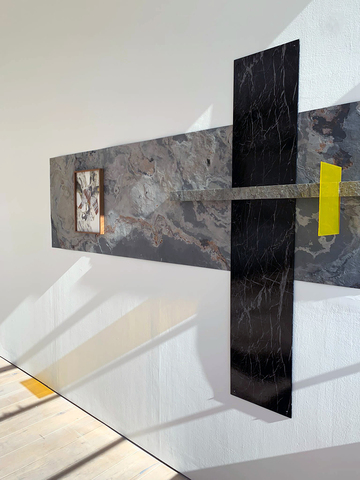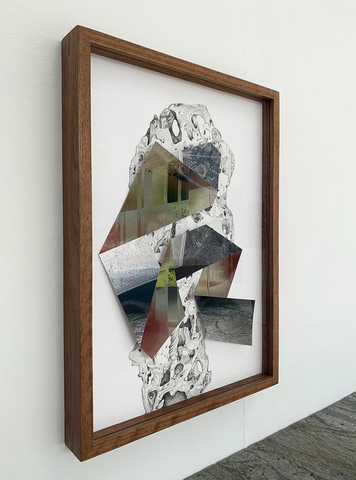The Barcelona Pavilion, designed by Ludwig Mies van der Rohe was the German Pavilion for the 1929 International World Exhibition in Barcelona. The building was used for the official opening of the German section of the exhibition. It is an important building in the history of Modern architecture, known for its simple form and its innovative construction, particularly using glass and steel. Despite its spectacular use of extravagant materials, such as marble, onyx and travertine, the building rejects any celebration of the ornament.
In A Scholar’s Rock , Klenz is not interested to present the Barcelona Pavilion as modern architecture synonymous with repetition, regularity, and mass production but instead her work interrupts regularity, turning the rational on its head. Klenz is interested to engage with dimensionality that allows the building to be seen and interpreted in multiple ways: from every other point of view, the building looks like something different. Her work distorts, multiplies and inverts the viewer's conception of space, leading him/her into a palace of illusion in which the depth of spaces is as hard to gauge.
In Klenz' presentation of the pavilion, the building is represented as an open-ended form in a state of perpetual becoming. The hard edges of the architectural structure fade into gradations of light: asymmetry and delicately broken horizons offer a different idea to the inflexible grid like structure and perfect order of the building itself.
The various photographs are presented as folded objects on pencil drawings of studies of various scholars' rocks. Like the pavilion itself, the photographic object shifts in appearance depending on the viewer’s perspective, becoming a baffling conundrum or kaleidoscopic merry-go-round.
Construction is part of this body of work, not just in the sense of constructed and built pavilion but also as a conceptual approach to what a photographic image can be: a transmutation of two dimensions back into three. Interestingly, Klenz' works do not represent the German Pavilion as a fixed object but rather presents many variables of the same building: the endless refractions and reflections change the pavilion into a building with endless combinations.
The works refer to scholars' rocks both by titling the body of work in this way but also by using pencil drawing studies of various scholars’ rocks as the backdrop of the folded image. A scholar’s rock functions as "vessels of modern fantasy and imagination” (Craig Clunas) suggesting plants, rocks, bodies, flames and mountains. They existed in nature before they became prized objects collected by museums and individuals. It is believed that this transition occurred in Qing Dynasty (1644-1911) but some date back to Ming Dynasty (1368-1664). The pleasure of studying a scholar’s rock is given by their presence, the endless variety of their surfaces, the mystery of their holes, quasi-architectural and quasi-somatic quality, the logic of their vertical joints and horizontal strata, the dynamism of their alternating expansions and recessions. The challenge and gift of a scholar’s rock is to sustain the play between observation and imagination and like Mies van der Rohe’s pavilion itself, A Scholar’s Rock brings the world into more complex and variable relations.
Between 1919 and 1927, El Lissitzky produced a large body of paintings, prints, and drawings that he referred to by the word Proun, an acronym for “project for the affirmation of the new” in Russian. These works were prototypes for visionary inhabitable abstractions in which the visitor could experience geometric shapes and linear vectors wrapping around corners and launching toward the ceiling. In his transformation of the two-dimensional works into “abstract rooms” (such as the Proun Room installed at the Greater Berlin Art Exhibition in 1923 or Abstraktes Kabinett in the Hanover Landesmuseum in 1927. ), Lissitzky was part of a general blurring of disciplinary boundaries.
What makes the works of Lissitzky interesting and divergent is that they include apparently contradictory domains by shifting different modes of representations - perspective, axonometry and photomontage. His radical re-conception of space and material is a metaphor for the fundamental transformations of two-dimensional planes into three-dimensional forms, in his own terms, to be ‘neither painting nor architecture but midway station between the two’.
In the exhibition display of A Scholar's Rock, Klenz includes ideas of Lissitzky by using coloured glass, glass shards, marble, travertine and shelfs that display the work from different angles to present Mies van der Rohe’s pavilion as ever-changing and ever-evolving. The exhibition of the work echos the pavilion’s endless variety of presence and like a scholar’s rock, the exhibition display creates shadows and shapes and refractions and reflections.






















